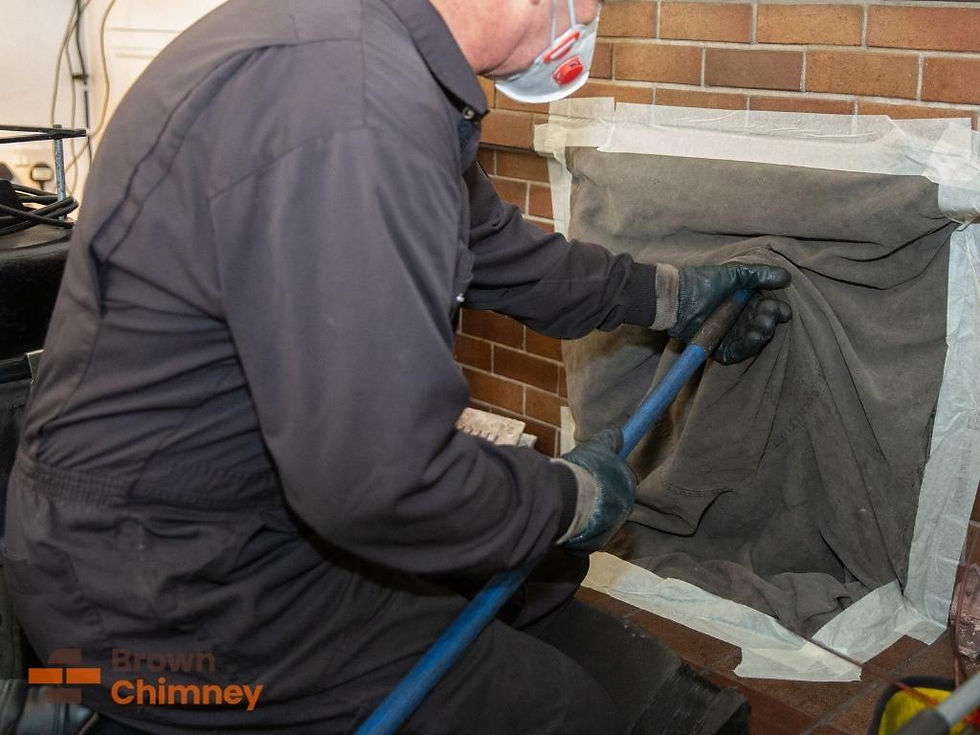Does My Chimney Still Need Waterproofing If I Barely Use It?
- Geri Mileva

- Sep 1
- 4 min read

Switched to central heating but still love the look of your fireplace? Maybe you only light a fire a few times a year—or not at all. That means it should be fine to skip waterproofing and annual inspections, right?
Even if you barely use your fireplace, you’d want to have it waterproofed and checked each year if you want to avoid costly repairs down the line.
3 reasons why your chimney needs waterproofing
Chimneys are exposed to environmental elements.
Whether you use it or not, your chimney takes a beating from rain, sun, snow, and wind. If you live in a high-wind zone, rain can be driven sideways into cracks and joints during storms or hurricanes. Fluctuating temperatures and freezing winters also expose it to a freeze/thaw cycle. When water seeps into tiny cracks, freezes, and expands, serious structural damage is inevitable over time.
Moisture wreaks havoc on unused chimneys.
Just because your chimney isn’t in use doesn’t mean it’s safe from damage. Unused chimneys often go unchecked and can deteriorate silently over time. Bricks, mortar, and stone may look solid, but they’re actually porous and absorb water like a sponge. Over time, trapped moisture in masonry chimneys can cause cracking, spalling, mortar erosion, efflorescence, mold and mildew growth, and many other issues.
Even modern fireplaces with prefab chimneys aren’t safe from water damage. Water can corrode metal components, degrade insulation, or create rust and leaks that ruin your interior walls or ceilings. It’s a slow, silent killer, no matter how often you use your chimney.
It may be required by building codes.
Some building codes require moisture control and sealing for chimneys regardless of how often they’re used. The International Residential Code, for instance, requires masonry chimneys to have a sloped chimney cap to keep water away from the flue. Some codes also require sealing liners to the masonry with water-insoluble refractory cement.
How to waterproof chimneys
When we hear waterproofing, we often think of applying a sealant to the exterior walls of a chimney. However, that’s just one part of the full waterproofing system. Keeping the entire structure safe from water penetration and damage requires several layers of protection.
Here are the basic steps in waterproofing chimneys:
Install a chimney cap or crown.
A chimney cap is a metal cover that sits on top of the flue to keep rain, snow, debris, and animals out. Below it, the chimney crown (usually concrete or mortar) slopes outward to shed water away from the sides of the chimney. If you already have these, check them regularly to make sure the crown isn’t cracked. A damaged crown is one of the top causes of chimney leaks.
Use proper flashing where the chimney meets the roof.
The spot where your chimney and roof connect is one of the most leak-prone areas on a home. To waterproof it properly, use a flashing system that typically includes base, step, and counter flashing. These metal pieces work together like puzzle pieces to keep water from sneaking in around the chimney base.
Add a cricket to redirect water.
If your chimney is on a sloped roof, rainwater naturally flows toward it and can collect behind it. A cricket or saddle flashing built behind the chimney helps prevent pooling by diverting water away. This small, peaked structure is highly recommended for chimneys that are more than 30 inches wide and for all sloped roofs.
Seal the brickwork with the right waterproofing treatment.
Masonry chimneys, in particular, must be sealed to keep them from soaking up water, but make sure it’s the right kind of waterproofing. Cheap sealants trap moisture inside and accelerate damage instead of preventing it. Professional-grade solutions like what we use at Brown Chimney allow your bricks to breathe. We apply vapor-permeable waterproofing treatment, which is specially formulated to block water from entering while allowing moisture already inside the bricks to evaporate.
Get a professional inspection.
The condition of your chimney, roof, and surrounding materials affects how water behaves. While there are tons of DIY tutorials online, there’s no single solution that works for all chimneys. You may just end up spending more on a popular hack that doesn’t quite work for your chimney.
To make sure everything is properly sealed and to catch early signs of damage, schedule a chimney inspection and waterproofing service with a licensed professional. They can check your chimney, assess external factors, and apply the right waterproofing solutions you need.
Regular maintenance for rarely used chimneys
Even if you rarely use your chimney, the environment within and around it changes constantly. To make sure it stays structurally safe, make sure you do these on schedule:
Inspect once a year. Even unused chimneys can crack, shift, or develop leaks.
Install a chimney cap and check it every year. Chimney caps keep rain, debris, and critters out. Since they’re exposed, they’re more prone to cracking.
Check the flashing and crown. These seal the chimney at roof level and the top, so they need to be in good shape.
Waterproof it. This is critical, especially if your chimney is exposed to open weather or is made of brick or stone. A small investment now avoids major costs later.
Remember, regular maintenance helps you spot issues while they’re still easy to fix.
Keeps your chimney in tiptop shape
Your chimney degrades due to natural elements even if you don’t use it. Moisture doesn’t care whether there’s a fire burning below or not. If it’s exposed to the elements, it needs protection.
Stop chimney leaks before they start. Schedule an inspection and book a waterproofing service with Brown Chimney. We’ll make sure your chimney stays solid and dry—even if you rarely use it.



